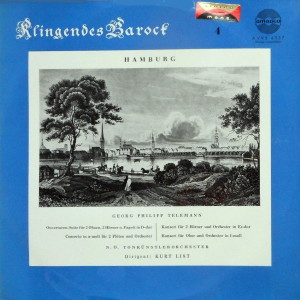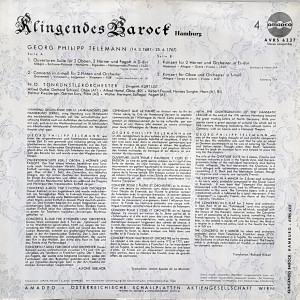 |
1 LP -
Amadeo AVRS 6334
|
 |
|
| HAMBURG -
Klingendes Barock - 4 |
|
|
|
|
|
| Georg Philipp
Telemann (14.3.1681 - 25.6.1767) |
|
|
| 1. Ouverturen-Suite
für 2 Oboen, 2 Hörner und Fagott
in D-dur |
14' 33" |
A1 |
| - Allegro -
Siziliano - Paysane - Menueto -
Rigaudon - Harlequinade (Presto) |
|
|
| 2. Concerto in
a-moll für 2 Flöten und Orchester |
9' 08" |
A2 |
| -
Gravement - Vistement - Largement
- Vivement |
|
|
| 3. Konzert für 2
Horner und Orchester in Es-dur |
13' 42" |
B1 |
| - Maestoso -
Allegro - Grave/Vivace |
|
|
| 4. Konzert für
Oboe und Orchester in f-moll |
8' 22" |
B2 |
| - Allegro -
Largo e piano - Vivace |
|
|
|
|
|
Alfred Dutka, Gerhard
Schiessl, Oboe (1)
|
N. Ö.
TONKÜNSTLERORCHESTER |
|
| Alfred Hertek,
Oboe (4) |
Kurt List, Dirigent |
|
| Robert Freund,
Hannes Sungler, Horn
(1,3) |
|
|
| Helmut
Riessberger, Gernot Kury,
Flöte (2) |
|
|
| Walter Hermann
Sallagar, Fagott (1) |
|
|
|
|
|
|
Luogo
e data di registrazione |
|
- |
|
|
Registrazione:
live / studio |
|
studio |
|
|
Edizione LP |
|
AMADEO
- AVRS 6337 - (1 lp) - durata 45'
45" - (p) 1966 - Analogico |
|
|
Altre edizioni
LP |
|
AMADEO
- AVRS 6337 - (1 lp) - (Edizione
francese Costallat, Paris)
MUSICAL HERITAGE
SOCIETY - MHS 528 - (1 lp) - (1)
MUSICAL HERITAGE
SOCIETY - MHS 743 - (1 lp) - (2,
4)
MUSICAL HERITAGE
SOCIETY - MHS 641/642 - (2 lp) -
(3)
|
|
|
Prima Edizione
CD |
|
- |
|
|
Note |
|
Stereo
compatibile
|
|
|
|
|
WITH THE
DISINTEGRATION OF THE
HANSEATIC LEAGUE at the
end of the 17th century
Hamburg became the great
trading-center of North
Germany. With prosperity
came a great upsurge of
cultural life which led to
18th century Hamburg
becoming the cultural
centre of Germany, with an
Opera and a National
Theatre.
GEORG
PHILIPP TELEMANN was one
of the most highly
thought of and prolific
composers of his day.
His versatility was such
that he was as adept at
German counterpoint as
he was at catering for
French and Italian
tastes. Though older
than Bach, Telemann
turned his back on
baroque form and helped
to pave the way for the
classics.
The
title of the OVERTURE
SUITE for 2 oboes, 2
horns and bassoon
indicates a Suite in
the French style, and
the programmatic
titles of the
individual movements
also betray French
influence. The first
movement, in the
Overture, is a brisk
Allegro with
rudimentary symptoms
of sonata form
resembling J. C. Bach
and the Mannheim
School, though its
elegance and vivacity
are typically French.
THE
CONCERTO IN A MINOR
for 2 flutes and
orchestra is an
early work, probably
composed at the
Ducal Court at
Eisenach. It was
here that Telemann
first became
acquainted with
French music, and
its influence is
clearly
discernible in
this work. The
Concerto opens
with a slow
introduction which
is followed by a quick
movement. If the
"Largement" is
typically
French, the
Rhytm of the
Finale is
typically
Telemann.
THE
CONCERT IN E
FLAT for 2
horns and
orchestra is
from Part III
of the
"Tafelmusik"
and was
originally
written for
"Waldhörner",
the use of
which, coupled
with the
nature of the
thematic
material,
makes the
Concerto a
sort of
panorama of a
hunting scene,
something like
a French
tapestry. In
the first
movement the
company
assembles, in
the second it
moves off into
the forest,
the third is a
respite in a
sheltered
valley, and in
the fourth the
hunt is in
full cry.
THE
CONCERTO IN
F MINOR for
oboe and
orchestra
probably dates
from
Telemann's
Frankfurt days
(1712-1721).
The first
movement is a
fugato, the
second a
leisurely
Siciliana in
which the
violas are
prominent. The
Finale, which
is strikingly
reminiscent of
Vivaldi, is
characterised
by dynamic
contrast.
ALFONS ÜBELHÖR
(Translation:
Richard
Rickett)
|
|

